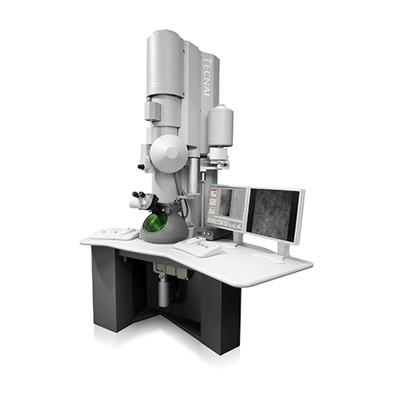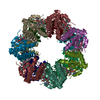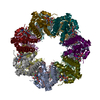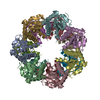[English] 日本語
 Yorodumi
Yorodumi- EMDB-7951: cryo-EM density map of ClpP from Staphylococcus aureus with bound... -
+ Open data
Open data
- Basic information
Basic information
| Entry | Database: EMDB / ID: EMD-7951 | |||||||||
|---|---|---|---|---|---|---|---|---|---|---|
| Title | cryo-EM density map of ClpP from Staphylococcus aureus with bound Acyldepsipeptide (V7A mutant) | |||||||||
 Map data Map data | ||||||||||
 Sample Sample |
| |||||||||
| Biological species |  | |||||||||
| Method | single particle reconstruction / cryo EM / Resolution: 5.6 Å | |||||||||
 Authors Authors | Ripstein ZA / Vahidi S / Kay LE / Rubinstein JL | |||||||||
 Citation Citation |  Journal: Proc Natl Acad Sci U S A / Year: 2018 Journal: Proc Natl Acad Sci U S A / Year: 2018Title: Reversible inhibition of the ClpP protease via an N-terminal conformational switch. Authors: Siavash Vahidi / Zev A Ripstein / Massimiliano Bonomi / Tairan Yuwen / Mark F Mabanglo / Jordan B Juravsky / Kamran Rizzolo / Algirdas Velyvis / Walid A Houry / Michele Vendruscolo / John L ...Authors: Siavash Vahidi / Zev A Ripstein / Massimiliano Bonomi / Tairan Yuwen / Mark F Mabanglo / Jordan B Juravsky / Kamran Rizzolo / Algirdas Velyvis / Walid A Houry / Michele Vendruscolo / John L Rubinstein / Lewis E Kay /   Abstract: Protein homeostasis is critically important for cell viability. Key to this process is the refolding of misfolded or aggregated proteins by molecular chaperones or, alternatively, their degradation ...Protein homeostasis is critically important for cell viability. Key to this process is the refolding of misfolded or aggregated proteins by molecular chaperones or, alternatively, their degradation by proteases. In most prokaryotes and in chloroplasts and mitochondria, protein degradation is performed by the caseinolytic protease ClpP, a tetradecamer barrel-like proteolytic complex. Dysregulating ClpP function has shown promise in fighting antibiotic resistance and as a potential therapy for acute myeloid leukemia. Here we use methyl-transverse relaxation-optimized spectroscopy (TROSY)-based NMR, cryo-EM, biochemical assays, and molecular dynamics simulations to characterize the structural dynamics of ClpP from (SaClpP) in wild-type and mutant forms in an effort to discover conformational hotspots that regulate its function. Wild-type SaClpP was found exclusively in the active extended form, with the N-terminal domains of its component protomers in predominantly β-hairpin conformations that are less well-defined than other regions of the protein. A hydrophobic site was identified that, upon mutation, leads to unfolding of the N-terminal domains, loss of SaClpP activity, and formation of a previously unobserved split-ring conformation with a pair of 20-Å-wide pores in the side of the complex. The extended form of the structure and partial activity can be restored via binding of ADEP small-molecule activators. The observed structural plasticity of the N-terminal gates is shown to be a conserved feature through studies of and ClpP, suggesting a potential avenue for the development of molecules to allosterically modulate the function of ClpP. | |||||||||
| History |
|
- Structure visualization
Structure visualization
| Movie |
 Movie viewer Movie viewer |
|---|---|
| Structure viewer | EM map:  SurfView SurfView Molmil Molmil Jmol/JSmol Jmol/JSmol |
| Supplemental images |
- Downloads & links
Downloads & links
-EMDB archive
| Map data |  emd_7951.map.gz emd_7951.map.gz | 14.7 MB |  EMDB map data format EMDB map data format | |
|---|---|---|---|---|
| Header (meta data) |  emd-7951-v30.xml emd-7951-v30.xml emd-7951.xml emd-7951.xml | 14.5 KB 14.5 KB | Display Display |  EMDB header EMDB header |
| Images |  emd_7951.png emd_7951.png | 67.3 KB | ||
| Archive directory |  http://ftp.pdbj.org/pub/emdb/structures/EMD-7951 http://ftp.pdbj.org/pub/emdb/structures/EMD-7951 ftp://ftp.pdbj.org/pub/emdb/structures/EMD-7951 ftp://ftp.pdbj.org/pub/emdb/structures/EMD-7951 | HTTPS FTP |
-Validation report
| Summary document |  emd_7951_validation.pdf.gz emd_7951_validation.pdf.gz | 78.7 KB | Display |  EMDB validaton report EMDB validaton report |
|---|---|---|---|---|
| Full document |  emd_7951_full_validation.pdf.gz emd_7951_full_validation.pdf.gz | 77.8 KB | Display | |
| Data in XML |  emd_7951_validation.xml.gz emd_7951_validation.xml.gz | 494 B | Display | |
| Arichive directory |  https://ftp.pdbj.org/pub/emdb/validation_reports/EMD-7951 https://ftp.pdbj.org/pub/emdb/validation_reports/EMD-7951 ftp://ftp.pdbj.org/pub/emdb/validation_reports/EMD-7951 ftp://ftp.pdbj.org/pub/emdb/validation_reports/EMD-7951 | HTTPS FTP |
-Related structure data
- Links
Links
| EMDB pages |  EMDB (EBI/PDBe) / EMDB (EBI/PDBe) /  EMDataResource EMDataResource |
|---|
- Map
Map
| File |  Download / File: emd_7951.map.gz / Format: CCP4 / Size: 15.6 MB / Type: IMAGE STORED AS FLOATING POINT NUMBER (4 BYTES) Download / File: emd_7951.map.gz / Format: CCP4 / Size: 15.6 MB / Type: IMAGE STORED AS FLOATING POINT NUMBER (4 BYTES) | ||||||||||||||||||||||||||||||||||||||||||||||||||||||||||||
|---|---|---|---|---|---|---|---|---|---|---|---|---|---|---|---|---|---|---|---|---|---|---|---|---|---|---|---|---|---|---|---|---|---|---|---|---|---|---|---|---|---|---|---|---|---|---|---|---|---|---|---|---|---|---|---|---|---|---|---|---|---|
| Projections & slices | Image control
Images are generated by Spider. | ||||||||||||||||||||||||||||||||||||||||||||||||||||||||||||
| Voxel size | X=Y=Z: 1.45 Å | ||||||||||||||||||||||||||||||||||||||||||||||||||||||||||||
| Density |
| ||||||||||||||||||||||||||||||||||||||||||||||||||||||||||||
| Symmetry | Space group: 1 | ||||||||||||||||||||||||||||||||||||||||||||||||||||||||||||
| Details | EMDB XML:
CCP4 map header:
| ||||||||||||||||||||||||||||||||||||||||||||||||||||||||||||
-Supplemental data
- Sample components
Sample components
-Entire : Caseinolytic protease from Staphylococcus aureus
| Entire | Name: Caseinolytic protease from Staphylococcus aureus |
|---|---|
| Components |
|
-Supramolecule #1: Caseinolytic protease from Staphylococcus aureus
| Supramolecule | Name: Caseinolytic protease from Staphylococcus aureus / type: complex / ID: 1 / Parent: 0 / Macromolecule list: all |
|---|---|
| Source (natural) | Organism:  |
| Recombinant expression | Organism:  |
| Molecular weight | Experimental: 301 KDa |
-Macromolecule #1: Caseinolytic protease from Staphylococcus aureus
| Macromolecule | Name: Caseinolytic protease from Staphylococcus aureus / type: protein_or_peptide / ID: 1 / Enantiomer: LEVO / EC number: endopeptidase Clp |
|---|---|
| Source (natural) | Organism:  |
| Recombinant expression | Organism:  |
| Sequence | String: MNLIPTAIET TNRGERAYDI YSRLLKDRII MLGSQIDDNV ANSIVSQLLF LQAQDSEKDI YLYINSPGGS VTAGFAIYDT IQHIKPDVQT ICIGMAASMG SFLLAAGAKG KRFALPNAEV MIHQPLGGAQ GQATEIEIAA NHILKTREKL NRILSERTGQ SIEKIQKDTD ...String: MNLIPTAIET TNRGERAYDI YSRLLKDRII MLGSQIDDNV ANSIVSQLLF LQAQDSEKDI YLYINSPGGS VTAGFAIYDT IQHIKPDVQT ICIGMAASMG SFLLAAGAKG KRFALPNAEV MIHQPLGGAQ GQATEIEIAA NHILKTREKL NRILSERTGQ SIEKIQKDTD RDNFLTAEEA KEYGLIDEVM VPETK |
-Experimental details
-Structure determination
| Method | cryo EM |
|---|---|
 Processing Processing | single particle reconstruction |
| Aggregation state | particle |
- Sample preparation
Sample preparation
| Concentration | 30 mg/mL | ||||||||||||||||||
|---|---|---|---|---|---|---|---|---|---|---|---|---|---|---|---|---|---|---|---|
| Buffer | pH: 7 Component:
| ||||||||||||||||||
| Grid | Support film - topology: HOLEY / Support film - Film thickness: 35.0 nm / Details: unspecified | ||||||||||||||||||
| Vitrification | Cryogen name: ETHANE-PROPANE / Chamber humidity: 100 % / Chamber temperature: 277 K / Instrument: FEI VITROBOT MARK III / Details: Modified Vitrobot. |
- Electron microscopy
Electron microscopy
| Microscope | FEI TECNAI F20 |
|---|---|
| Image recording | Film or detector model: GATAN K2 SUMMIT (4k x 4k) / Detector mode: COUNTING / Digitization - Dimensions - Width: 3838 pixel / Digitization - Dimensions - Height: 3710 pixel / Digitization - Frames/image: 1-30 / Number grids imaged: 1 / Number real images: 75 / Average exposure time: 15.0 sec. / Average electron dose: 35.0 e/Å2 |
| Electron beam | Acceleration voltage: 200 kV / Electron source:  FIELD EMISSION GUN FIELD EMISSION GUN |
| Electron optics | Calibrated defocus max: 4.2 µm / Calibrated defocus min: 1.2 µm / Illumination mode: FLOOD BEAM / Imaging mode: BRIGHT FIELD / Cs: 2.0 mm / Nominal magnification: 25000 |
| Sample stage | Specimen holder model: GATAN 626 SINGLE TILT LIQUID NITROGEN CRYO TRANSFER HOLDER Cooling holder cryogen: NITROGEN |
| Experimental equipment |  Model: Tecnai F20 / Image courtesy: FEI Company |
 Movie
Movie Controller
Controller













 Z (Sec.)
Z (Sec.) Y (Row.)
Y (Row.) X (Col.)
X (Col.)





















